RushFPV is known for its easy-to-use, solder-free flight controllers. This review will examine their latest BLADE F7 45A AIO flight module with a built-in 45A ESC.
An AIO (All-In-One) flight controller is a type of flight control system used primarily in compact FPV drones. AIOs integrate multiple components necessary for drone flight into a single circuit board. This integration commonly includes the flight controller (FC) itself, which is the brain of the drone, along with an electronic speed controller (ESC) for each motor, Power Distribution Board (PDB), voltage regulators (BEC), Telemetry module (OSD) and sometimes even built-in radio receivers (RX) and video transmitters (VTX).
The primary advantage of the RushFPV BLADE F7 AIO flight controller is its compactness and ease of installation. Combining several components that traditionally require separate installation and wiring simplifies the build process, reduces weight, and often improves reliability due to fewer connections that could potentially fail. The BLADE F7 AIO is almost plug-and-play; you just need to solder the battery cable and motors, and the rest of the accessories are plugged into the dedicated onboard connectors.
While AIO flight controllers offer numerous advantages, they also have disadvantages compared to traditional separate boards, such as higher prices, rigidity in design, and limited upgrades. Additionally, the cost of replacing the entire board in case of failure is much higher than replacing just an individual part.
RushFPV F7 AIO flight controller review
Disclosure: I received this AIO flight controller in a product review collaboration with RushFPV. Although the board was offered for free, all opinions in this article remain mine, and the sponsor did not influence me.
The Blade F7 AIO comes in a zipped antistatic bag with many included cables, a USB Type-C board, and five (4+1spare) anti-vibration rubber grommets. No printed wiring diagram, XT60/XT30 battery cable, or Low ESR capacitor was provided.
The double-sided PCB measures 33*33 mm and weighs around 9 grams. It has a 25.5*25.5mm-26.5*26.5mm mounting pattern and should be installed in a rhombus position. Many websites advertise it with a 30.5×30.5mm mounting, but this is wrong!
A plastic sheet with labels on it protects both sides from dust. It has only motor and battery solder tabs; the rest of the in/out ports are accessible through dedicated connectors. On the front (with the direction arrow), it has HD Unit (Bat, GND, TX4, RX4, TX2, and RX2), CAM VTX (CAM, GND, 5V, 5V, GND< VTX, and TX4), and RC/LED (GND, 5V, RX1, TX1, GND, 5V, and LED) connectors. Two more connectors are on the back: USB (Buzz-, 5V, GND, Boot, Data+, and Data-) and GNSS (SCL, SDA, TX5, RX5, 5V, and GND). It has only two status LEDs (PWR/SAT) next to the motor1 solder pads.

There is a 5V BEC onboard, so digital VTXs are powered directly from the main battery. When using 6S batteries, you may need an external 10V BEC for some digital VTXs that work up to 4S.
Blade F7 AIO: No USB! How do you upgrade firmware and configure it?
Instead of an onboard USB port, RushFPV opted for an external Type-C module. This approach gives you wider flexibility in installing the flight controller, especially in a closed frame where the USB would normally be inaccessible (covered by frame parts). Many F7 boards have onboard Bluetooth connectivity to configure the flight controller remotely. It’s a pity that RushFPV didn’t think to add such capabilities to their newest AIO flight controller.

The tiny USB-C module also includes the “DFU\Boot” button required for bootloader upgrade. As you can see in the connection diagram above, the USB connector is shared with the buzzer port, so you will need to craft a splitter cable to use both simultaneously.
Out of the box, the Blade F7 AIO comes with BetaFlight 4.4.0 (target Blade_F7_AIO). As the next version (BF 4.5) is still a candidate release (RC2), I recommend staying with stock firmware, which is more stable. The software on the integrated 45A ESC can be upgraded and configured using the BLHeli_32 tool.
Rush Blade F7 45A AIO technical specifications
| MCU | STM32F722 |
| ESC CPU | AT32F421 4X |
| Barometer | BMP280 |
| Gyro | ICM42688P |
| BLACKBOX | 16MB FLASH |
| BEC | 5V 1A |
| UART PORTS | UART1: Receiver UART2: Air Unit S.Bus UART3: ESC Telemetry UART4: VTX Control/HD-MSP UART5: Navigation GPS |
| Other outputs | LED strip |
| Software | BetaFlight 4.4.0 |
| Firmware target | FC: Blade_F7_AIO ESC: BLHeli_32 Rush_Blade_F4_AIO |
| Battery | Up to 6S LIPO |
| Size | 33*33 mm |
| Mounting holes | 25.5*25.5mm-26.5*26.5mm |
| Weight | 9 grams (without cables) |
Pricing and availability
The Blade F7 AIO flight controller can be ordered from RushFPV for $90.99. The FC was “sold out” when I published my review but will probably be restocked soon. RushFPV products are also available on Amazon, Aliexpress, and other popular RC retailers, such as GetFPV and Banggood.
Blade F7 AIO FC: What’s for?
The Blade F7 AIO flight controller suits various types of custom-made FPV drones. With a 25.5*25.5mm mounting pattern, it can be installed in compact CineWhoop-style FPV drones, but thanks to its powerful 45A ESC, it is also suitable for 5″ racing drones. It has analog and digital VTX connectors, making it compatible with both FPV systems.
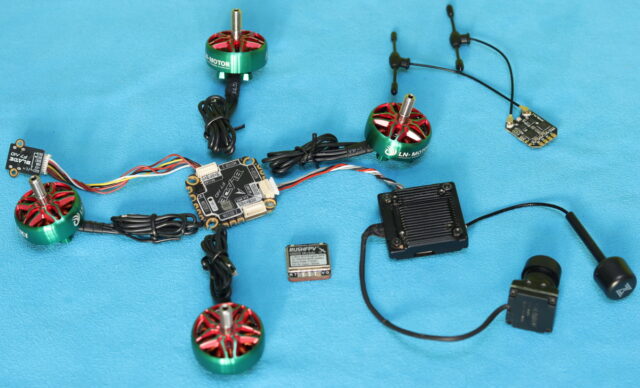
I plan to build an ultra-light FPV using a FlyFish Atlas 4″ frame kit, Walksnail Avatar HD Pro FPV system, RushFPV M10 mini GPS module, RadioMaster RP4TD ELRS radio receiver, and this Blade F7 AIO flight module. The drone should be powerful enough to carry a GoPro 12 but stay under 250 grams without an extra payload.
Rush BLADE F7 45A AIO: Alternatives
All important flight controller manufacturers offer AIO boards. I can name some of them: iFlight Beast F7 45A AIO, Axisflying Argus F7 AIO, T-Motor F7 45A AIO, Aikon F7 Mini 45A, GEPRC GEP-F722-45A AIO V2, and Foxeer Reaper F745 AIO. These BLADE F7 AIO alternatives are priced between $80 and $120. Of course, if you don’t need an integrated 45A ESC, there are many other options with 25A and 35A for less money.
Most AIO FCs mentioned above have similar features to the BLADE F7 AIO, except for the plug-and-play design with onboard connectors, which is the silver bullet for easily building a DIY FPV drone.

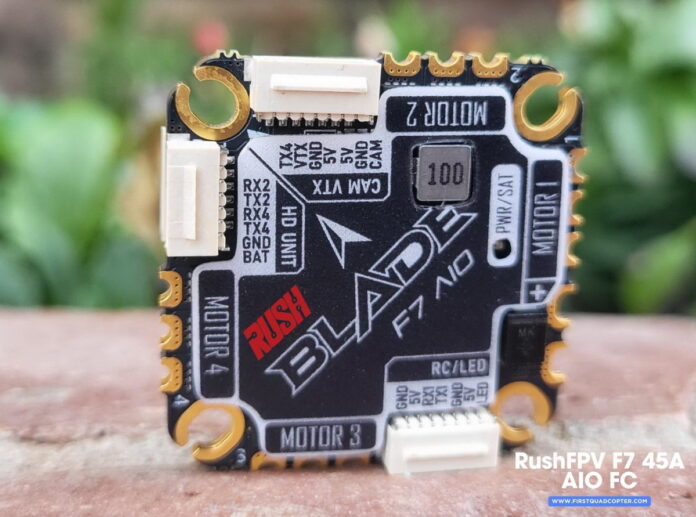
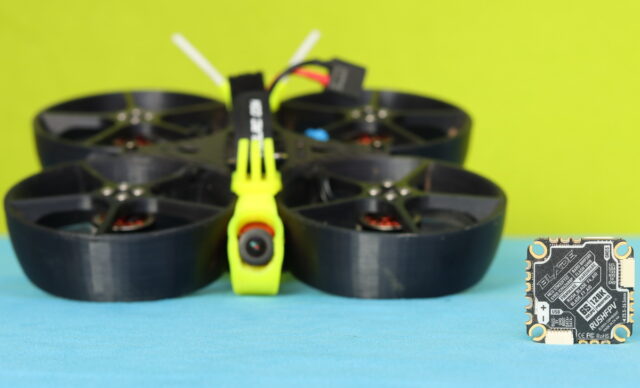
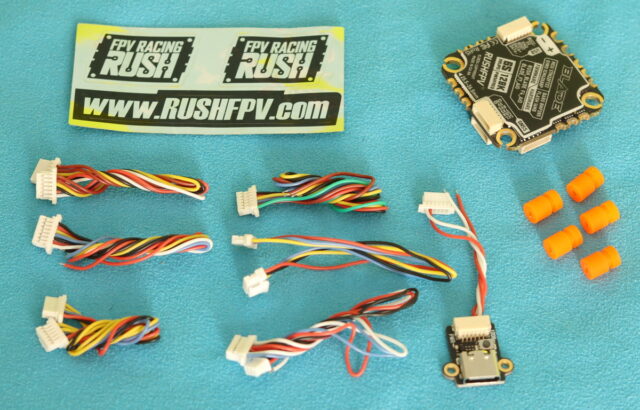

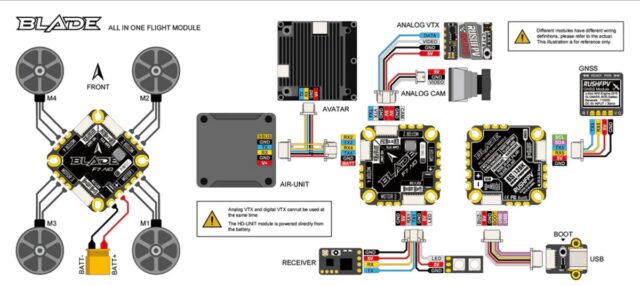
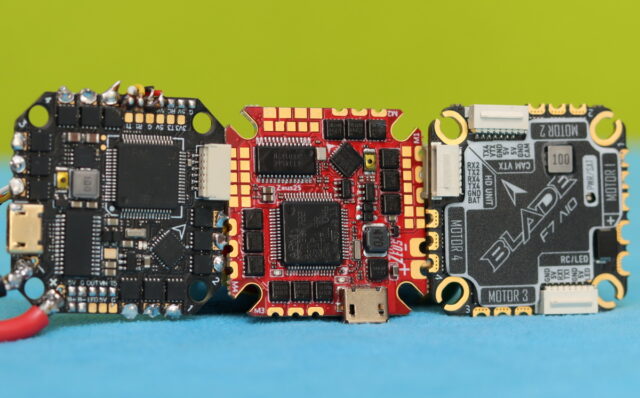
The new GEPRC TAKER G4 45A AIO feels better made compared to the RushFPV BLADE F7 AIO and it costs less!
Can it be installed on a FPV drone with a 30×30 mount?
Yest, but you will need an 25x25mm to 30x30mm adapter. you can 3d print one!
This will be perfect for my new GEPRC CineLog35 V2 frame